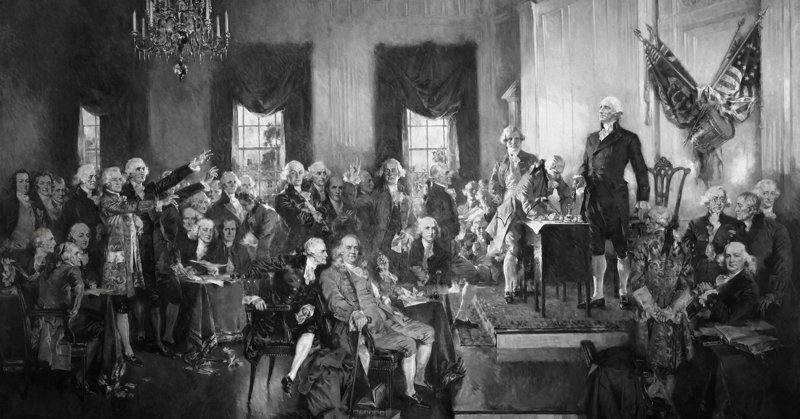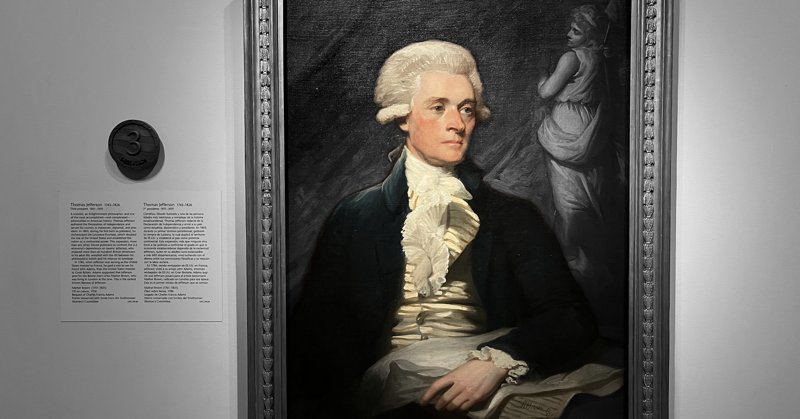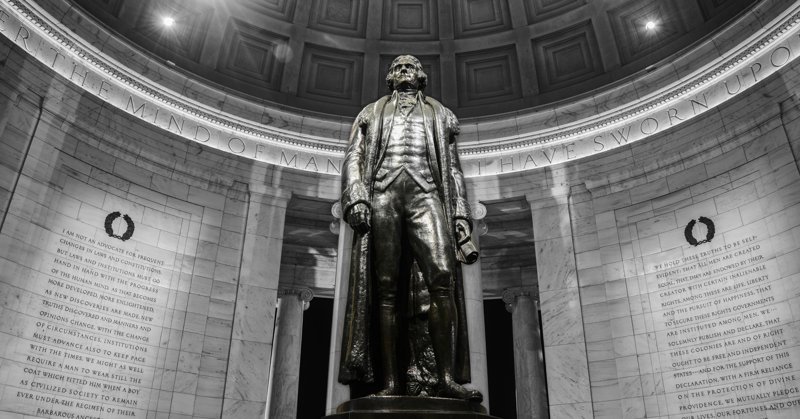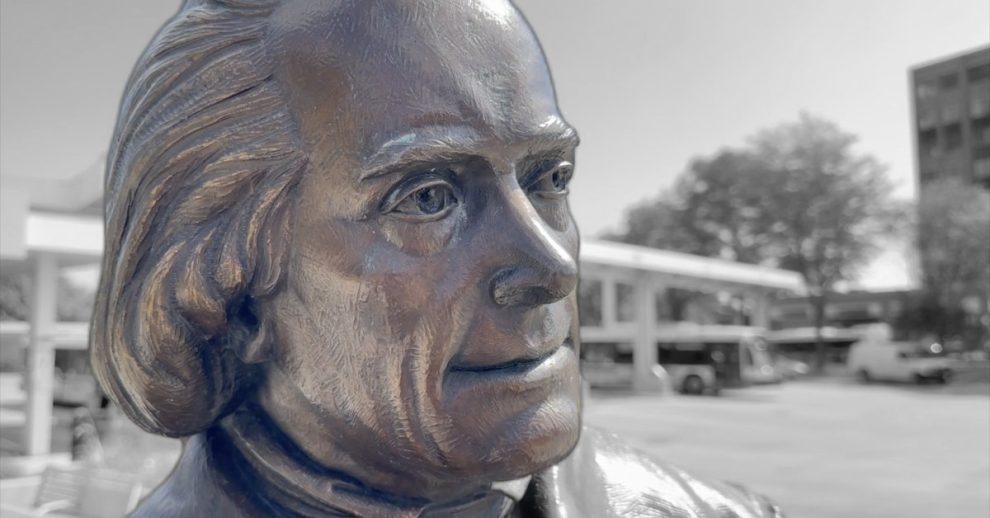Thomas Jefferson wasn’t just the guy on the nickel or the face behind Monticello—he was a walking contradiction, a curious tinkerer, and a revolutionary thinker who helped shape a brand-new nation. Born in Virginia in 1743, he had a mind that bounced between philosophy, politics, science, and even food (yes, mac and cheese owes him a nod). By the time America was breaking free from Britain, Jefferson was already making history with his pen, drafting the Declaration of Independence and carving his place among the Founding Fathers. Fast forward a few years, and this book-loving, idea-obsessed Virginian stepped into the presidency, where he doubled the size of the country with the Louisiana Purchase and sent explorers westward on epic adventures. Jefferson wasn’t perfect—but he was endlessly fascinating, and his influence still echoes today.
Founding Fathers’ Youthful Age

1. Contrary to the common depiction of the Founding Fathers as older men, they were quite young during the American Revolution. On July 4, 1776, Aaron Burr was 20, Alexander Hamilton was 21, James Madison was 25, John Jay was 29, and Thomas Jefferson was 33.
2. In the 1800 U.S. presidential election, Thomas Jefferson and Aaron Burr ended in an exact tie, prompting the decision to move to the House of Representatives to select a president. The House cast votes 35 times, each resulting in a tie, until Jefferson finally secured the presidency on the 36th vote.
3. When a French scientist claimed that American wildlife was inferior to European wildlife, Thomas Jefferson took offense and decided to take action. He instructed a group of soldiers to procure and send a bull moose from New Hampshire to the scientist in Paris. This gesture was meant to demonstrate the “stature and majesty of American quadrupeds,” and they successfully delivered a giant moose carcass to Paris.
4. Thomas Jefferson’s interest in natural history led him to send Lewis and Clark on an expedition to map the American West. He hoped they might discover living mastodons, large, extinct, elephant-like mammals. Jefferson was fascinated by the fossils being found across North America and believed these creatures might still roam the unexplored territories.
5. Thomas Jefferson created his own version of the Bible, known as The Jefferson Bible, by meticulously cutting and pasting passages from Greek, Latin, French, and English Bibles. He focused solely on Jesus’ moral teachings, intentionally omitting references to miracles. Jefferson used a razor to extract passages from the New Testament and assembled them into a cohesive text, which is now on display at the Smithsonian. He believed Jesus’s teachings represented “the most sublime and benevolent code of morals” but felt that followers had diluted them with political agendas.
6. Thomas Jefferson’s culinary curiosity was evident during his time in Paris, where he encountered macaroni and cheese. He documented the recipe and instructions on pasta extrusion, imported a pasta maker and Parmesan, and prepared it at his home. In 1802, he served it at a state dinner, introducing America to this dish. Jefferson later also introduced waffles, Parmesan, olive oil, and champagne to American cuisine during his lifetime.
7. The term “French fries” originates from the “French cut,” which refers to “julienning” vegetables. In 1802, Thomas Jefferson requested “potatoes served in the French manner” for a White House meal, popularizing the term.
8. In a 1789 letter to James Madison, Thomas Jefferson proposed that the Constitution and laws should expire after 19 years. He believed this would allow new generations to learn from the past and adapt accordingly. Jefferson aimed to prevent older generations from “binding” future ones with outdated laws.
9. Thomas Jefferson kept a Shetland sheep on the White House lawn, which he described as “this abominable animal.” The sheep had a reputation for attacking people who took shortcuts across the lawn, injuring several individuals and even killing a small boy.
10. In 1790, Thomas Jefferson proposed a decimal-based system for weight, length, and volume, which predated the metric system. If adopted, 1 mile would equal 10,000 feet, an inch would be divisible by 10, and 1 cubic foot would equal exactly 1,000 ounces. However, pirates kidnapped Joseph Dombey, the French scientist sent to help Jefferson persuade Congress, derailing the plan and possibly preventing the U.S. from adopting the metric system.
Jefferson’s Swivel Chair Invention

11. Thomas Jefferson invented the first swivel chair and used it while drafting the United States Declaration of Independence in 1776. This innovative chair allowed Jefferson to rotate while working, which was revolutionary at the time.
12. In 1784, Thomas Jefferson proposed a bill to end slavery in all U.S. territories. Unfortunately, Congress narrowly defeated the bill by just one vote.
13. After the British burned the Library of Congress in 1814, Thomas Jefferson offered his extensive personal library as a replacement. Although some opposed the contents of his collection, Jefferson insisted on including a wide range of subjects. His donation helped transform the library from a niche institution into a national treasure.
14. During the War of 1812, Thomas Jefferson believed annexing Canada and expelling the British from North America would be straightforward, describing it as “a mere matter of marching.” However, the Canadian population largely consisted of British loyalists, and U.S. invasions failed disastrously.
15. Thomas Jefferson founded the University of Virginia because he found Virginia’s only other college at the time, the College of William & Mary, was too religious and did not have enough science courses.
16. The catchphrase “my name is Haines” became popular in the 1800s when someone needed to leave quickly. This phrase originated from a man’s awkward encounter with Thomas Jefferson. In 1840 a newspaper said it had “a popularity that no other slang phrase has ever attained.”
17. Thomas Jefferson was fluent in English, Greek, Latin, French, Italian, and Spanish. Additionally, he studied Arabic, Gaelic, and Welsh, making him the most multilingual president of the United States.
18. The quote “A government big enough to give you everything you need, is a government big enough to take away everything that you have” is often incorrectly attributed to Thomas Jefferson. In reality, it was Gerald Ford who first said this.
19. Thomas Jefferson conducted the first legitimate archaeological dig in history, proving that Native Americans, not a “lost race” of white people, created the massive burial mounds in Virginia.
20. Deists believe in a higher being but rely on logic and reason rather than religious texts or traditions. Notable deists include Thomas Jefferson, Benjamin Franklin, Napoleon Bonaparte, Voltaire, and Thomas Paine.
Founding Fathers and Hemp Farming

21. George Washington and Thomas Jefferson were hemp farmers who preferred smoking the plant’s flower over using tobacco or alcohol. In 1987, the DEA also raided Jefferson’s Monticello estate, removing poppy plants that had been continually cultivated there since Jefferson’s time. Jefferson also reportedly used opium derived from these poppies.
22. When Marquis de Lafayette, the French aristocrat and Revolutionary War hero who fought alongside the Americans, visited the United States in 1824, he and former President Thomas Jefferson, his close friend and political ally during the Revolution, collapsed in each other’s arms and wept upon reuniting. They had not seen each other since 1789, after Lafayette’s return to France amid the French Revolution, marking a 35-year separation. Jefferson was so overcome with emotion that he asked someone else to read the welcome speech he had prepared.
23. As early as 1802, Thomas Jefferson designed a cipher wheel to encrypt messages. Although it is unknown if he ever built or used one, the U.S. Army later invented a similar tool, which they used from 1920 until the start of World War II. Shortly after, researchers discovered Jefferson’s original designs.
24. Thomas Jefferson authored the Virginia Act for Establishing Religious Freedom, declaring it was “meant to comprehend, within the mantle of its protection, the Jew, the Gentile, the Christian, the Mahometan, the Hindoo, and the Infidel of every denomination.” This act is one of three great accomplishments inscribed on his gravestone.
25. Thomas Jefferson wrote his own epitaph, notably excluding any mention of his presidency. The epitaph reads: “Here was buried Thomas Jefferson, Author of the Declaration of American Independence, of the Statute of Virginia for Religious Freedom, and Father of the University of Virginia.”














Add Comment